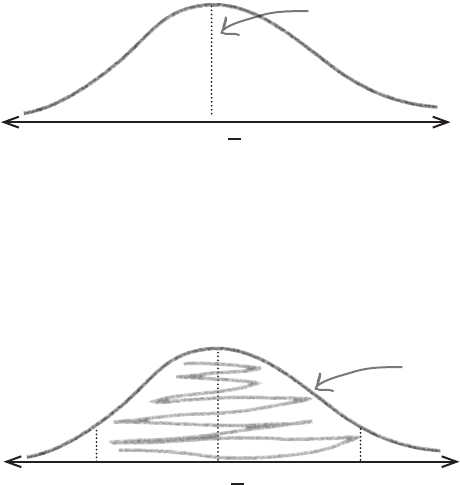Griffiths D. Head First Statistics
Подождите немного. Документ загружается.


you are here 4 481
estimating populations and samples
As n gets larger, X gets closer and closer to a normal distribution. We’ve
already seen that X is normal if X is normal. If X isn’t normal, then we can
still use the normal distribution to approximate the distribution of X if n is
sufficiently large.
In our current situation, we know what the mean and variance are for the
population, but we don’t know what its distribution is. However, since our
sample size is 30, this doesn’t matter. We can still use the normal distribution
to find probabilities for X.
This is called the central limit theorem.
Introducing the Central Limit Theorem
The central limit theorem says that if you take a sample from a non-normal
population X, and if the size of the sample is large, then the distribution of
X is approximately normal. If the mean and variance of the population are
μ and σ
2
, and n is , say, over 30, then
X ~ N(μ, σ
2
/n)
Does this look familiar? It’s the same distribution that we had when X
followed a normal distribution. The only difference is that if X is normal,
it doesn’t matter what size sample you use.
This is the mean
and variance of X.
If n is large, X can still be approximated by the normal distribution
By the central limit theorem, if your sample of X is
large, then X’s distribution is approximately normal.

482 Chapter 11
Using the central limit theorem
So how does the central limit theorem work in practice? Let’s take a look.
The binomial distribution
Imagine you have a population represented by X ~ B(n, p) where n is greater
than 30. As we’ve seen before, μ = np, and σ
2
= npq.
The central limit theorem tells us that in this situation, X ~ N(μ, σ
2
/n). To find
the distribution of X, we substitute in the values for the population. This means
that if we substitute in values for μ = np and σ
2
= npq, we get
X ~ N(np, pq)
For the binomial distribution, the mean of the population is
np, and the variance is npq. If we substitute this into the
sampling distribution, we get X ~ N(np, pq).
The Poisson distribution
Now suppose you have a population that follows a Poisson distribution of
X ~ Po(λ), again where n is greater than 30. For the Poisson distribution,
μ = σ
2
= λ.
As before, we can use the normal distribution to help us find probabilities for X.
If we substitute population parameters into X ~ N(μ, σ
2
/n), we get:
X ~ N(λ, λ/n)
Finding probabilities
Since X follows a normal distribution, this means that you can use standard
normal probability tables to look up probabilities. In other words, you can
find probabilities in exactly the same way you would for any other normal
distribution.
In general, you take the distribution X ~ N(μ, σ
2
/n) and substitute in values for
μ and σ
2
.
For the Poisson distribution, the mean and variance
are both λ. If we substitute this into the sampling
distribution, we get X ~ N(λ, λ/n).
central limit theorem

you are here 4 483
estimating populations and samples
Let’s apply this to Mighty Gumball’s problem.
The mean number of gumballs per packet is 10, and the variance is 1. If you take a sample of 30
packets, what’s the probability that the sample mean is 8.5 gumballs per packet or fewer? We’ll
guide you through the steps.
1. What’s the distribution of X?
2. What’s the value of P(X < 8.5)?

484 Chapter 11
Let’s apply this to Mighty Gumball’s problem.
The mean number of gumballs per packet is 10, and the variance is 1. If you take a sample of 30
packets, what’s the probability that the sample mean is 8.5 gumballs per packet or fewer? We’ll
guide you through the steps.
1. What’s the distribution of X?
We know that X ~ N(μ, σ
2
/n), μ = 10, σ
2
= 1, and n = 30, and 1/30 = 0.0333. So this gives us
X ~ N(10, 0.0333)
2. What’s the value of P(X < 8.5)?
As X ~ N(10, 0.0333), we need to find the standard score of 8.5 so that we can look up the result in
probability tables. This gives us
z = 8.5 - 10
0.0333
= -8.22 (to 2 decimal places)
P(Z < z) = P(Z < -8.22)
This probability is so small that it doesn’t appear on the probability tables. We can assume that an event with a
probability this small will hardly ever happen.
exercise solution

you are here 4 485
estimating populations and samples
Q:
Do I need to use any continuity
corrections with the central limit
theorem?
A: Good question, but no you don’t.
You use the central limit theorem to find
probabilities associated with the sample
mean rather than the values in the sample,
which means you don’t need to make any
sort of continuity correction.
Q:
Is there a relationship between
point estimators and sampling
distributions?
A: Yes, there is.
Let’s start with the mean. The point estimator
for the population mean is x, which means
that μ = x. Now, if we look at the expectation
for the sampling distribution of means, we
get E(X) = μ. The expectation of all the
sample means is given by μ, and we can
estimate μ with the sample mean.
Similarly, the point estimator for the
population proportion is p
s
, the sample
proportion, which means that p = p
s
. If
we take the expectation of all the sample
proportions, we get E(P
s
) = p. The
expectation of all the sample proportions is
given by p, and we can estimate p with the
sample proportion.
We’re not going to prove it, but we get a
similar result for the variance. We have
σ
2
= s
2
, and E(S
2
) = σ
2
.
Q:
So is that a coincidence?
A: No, it’s not. The estimators are chosen
so that the expectation of a large number
of samples, all of size n and taken in the
same way, is equal to the true value of
the population parameter. We call these
estimators unbiased if this holds true.
An unbiased estimator is likely to be
accurate because on average across all
possible samples, it’s expected to be the
value of the true population parameter.
Q:
How does standard error come into
this?
A: The best unbiased estimator for a
population parameter is generally one with
the smallest variance. In other words, it’s the
one with the smallest standard error.
The sampling distribution of means is what
you get if you consider all possible samples of
size n taken from the same population and form
a distribution out of their means. We use X to
represent the sample mean random variable.
The expectation and variance of X are defined as
E(X) = μ
Var(X) = σ
2
/n
where μ and σ
2
are the mean and variance of the
population.
The standard error of the mean is the standard
deviation of this distribution. It’s given by
Var(X)
If X ~ N(μ, σ
2
), then X ~ N(μ, σ
2
/n).
The central limit theorem says that if n is large
and X doesn’t follow a normal distribution, then
X ~ N(μ, σ
2
/n)
^

486 Chapter 11
Sampling saves the day!
The work you’ve done is awesome! My top customer
found an average of 8.5 gumballs in a sample of 30
packets, and you’ve told me the probability of getting
that result is extremely unlikely. That means I
don’t have to worry about compensating disgruntled
customers, which means more money for me!
You’ve made a lot of progress
Not only have you been able to come up with point
estimators for population parameters based on a single
sample, you’ve also been able to use population to calculate
probabilities in the sample. That’s pretty powerful.
hooray for gumball sampling

this is a new chapter 487
constructing confidence intervals
12
Guessing with Confidence
Sometimes samples don’t give quite the right result.
You’ve seen how you can use point estimators to estimate the precise value of the
population mean, variance, or proportion, but the trouble is, how can you be certain that
your estimate is completely accurate? After all, your assumptions about the population
rely on just one sample, and what if your sample’s off? In this chapter, you’ll see another
way of estimating population statistics, one that allows for uncertainty. Pick up your
probability tables, and we’ll show you the ins and outs of confidence intervals.
I put this in the
oven for 2.5 hours, but
if you bake yours for
1—5 hours, you should
be fine.

488 Chapter 12
Mighty Gumball is in trouble
We’re in trouble. Someone
else has conducted
independent tests and come
up with a different result.
They’re threatening to sue,
and that will cost me money.
Mighty Gumball used a sample of 100 gumballs to come up with a
point estimator of 62.7 minutes for the mean flavor duration, and
25 minutes for the population variance. The CEO announced on
primetime television that gumball flavor lasts for an average of 62.7
minutes. It’s the best estimate for flavor duration that could possibly
have been made based on the evidence, but what if it gave a slightly
wrong result?
If Mighty Gumball is sued because of the accuracy of their claims,
they could lose a lot of money and a lot of business. They need your
help to get them out of this.
The Mighty Gumball CEO has gone ahead with a range of
television advertisements, and he’s proudly announced exactly
how long the flavor of the super-long-lasting gumballs lasts for,
right down to the last second.
Unfortunately...
What do you think could have gone wrong? Should Mighty Gumball
have used the precise value of the point estimator in their advertising?
Why? Why not?
They need you to save them
another flavor favor

you are here 4 489
constructing confidence intervals
The problem with precision
As you saw in the last chapter, point estimators are the best estimate
we can possibly give for population statistics. You take a representative
sample of data and use this to estimate key statistics of the population
such as the mean, variance, and proportion. This means that the point
estimator for the mean flavor duration of super-long-lasting gumballs
was the best possible estimate we could possibly give.
The problem with deriving point estimators is that we rely on the
results of a single sample to give us a very precise estimate. We’ve
looked at ways of making the sample as representative as possible by
making sure the sample is unbiased, but we don’t know with absolute
certainty that it’s 100% representative, purely because we’re dealing
with a sample.
Now hold it right there!
Are you saying that point
estimators are no good?
After all that hard work?
Point estimators are valuable, but they may give
slight errors.
Because we’re not dealing with the entire population, all we’re doing
is giving a best estimate. If the sample we use is unbiased, then the
estimate is likely to be close to the true value of the population. The
question is, how close is close enough?
Rather than give a precise value as an estimate for the population
mean, there’s another approach we can take instead. We can specify
some interval as an estimation of flavor duration rather than a very
precise length of time. As an example, we could say that we expect
gumball flavor to last for between 55 and 65 minutes. This still gives
the impression that flavor lasts for approximately one hour, but it
allows for some margin of error.
The question is, how do we come up with the interval? It all depends
how confident you want to be in the results...

490 Chapter 12
Introducing confidence intervals
Up until now, we’ve estimated the mean amount of time that gumball flavor
lasts for by using a point estimator, based upon a sample of data. Using the
point estimator, we’ve been able to give a very precise estimate for the mean
duration of the flavor. Here’s a sketch showing the distribution of flavor
duration in the sample of gumballs.
With point estimators, we
estimate the population mean
using the mean of the samples.
So what happens if we specify an interval for the population mean instead?
Rather than specify an exact value, we can specify two values we expect
flavor duration to lie between. We place our point estimator for the mean
in the center of the interval and set the interval limits to this value plus or
minus some margin of error.
Rather than give a precise estimate for
the population mean, we can say that the
population mean is between values a and b.
The interval limits are chosen so that there’s a specified probability of the
population mean being between a and b. As an example, you may want to
choose a and b so that there’s a 95% chance of the interval containing the
population mean. In other words, you choose a and b so that
P(a < μ < b) = 0.95
We represent this interval as (a, b). As the exact value of a and b depends
on the degree of confidence you want to have that the interval contains the
population mean, (a, b) is called a confidence interval.
So how do we find the confidence interval for the population mean?
μ = x
^
b
a
μ = x
^
all about confidence intervals
